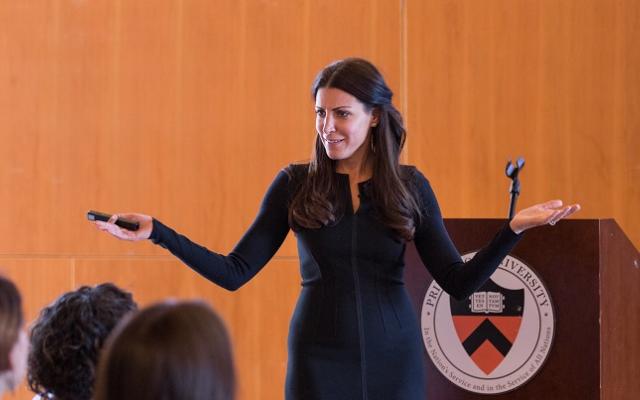
On a recent spring day the Keller Center gathered a crowd of 50 + people at the Carl A. Fields Center on Princeton University’s campus to hear a truly inspiring story of how the simple idea of sharing knowledge and technology brought water and electricity to one million people in rural Africa. But water and electricity were just the beginning.
The talk by Innovation: Africa founder and CEO Sivan Ya’ari was cosponsored by Princeton’s Center for Jewish Life (CJL) and the Keller Center. Rabbi Julie Roth, CJL’s Executive Director, provided the introduction, thanking University Trustee Mitch Julis ‘77 for connecting Sivan to Princeton and telling the audience that after she heard Sivan’s story, she asked herself, “How might my life be different and the world be different if I lived a little more like Sivan?”
Sivan’s story in Africa began when she took a job working quality control for the Jordache Clothing Company’s factory in Madagascar. She teased the students in the audience that they may be too young to know about the iconic 1980s designer jeans and assured them that they were very popular at the time. Once settled in Africa, Sivan was startled by the extreme poverty in the area and was shocked when invited to the homes of some of the workers in her factory to discover they lived without electricity and access to clean water. Sivan herself grew up poor but said ‘true poverty is different.’
As a small child, Sivan’s parents moved from Israel to France to build a better life for their family. They made their living selling pizza in the market and although they ate pizza for breakfast, lunch, and dinner Sivan always had a safe place to live, food, water, clean clothes, and access to a good education.
Spending time with the local villagers, Sivan saw firsthand how the absence of electricity had a trickle-down effect on the community’s health, ability to get a good education, and opportunities to work and prosper. So she came up with a simple solution: she went to her friends in Tel Aviv and asked them to share their innovations of affordable easy to install solar systems. With minimal effort she raised $4270 to purchase the solar panels and had them installed at the local clinic, and at the school. Electricity at the clinic meant that they could have a small refrigerator to store medicines, and the benefit of electricity enticed trained doctors to work there. Electricity at the school meant all students could see the lessons of the day. On the surface, it seemed she had found an easy solution and quick success.
When Sivan returned just six months later, she found that the teacher at the school was not using the electricity, because the light bulbs had blown out and she could not afford new ones. She also noticed that most of the girls in the village were absent from school, because they were needed at home to help gather water for their families, often walking miles only to find stagnate, disease-ridden puddles.
Sivan’s next challenge was how to create sustainability for the electricity at the school. So she came up with another plan. Although many Africans do not have access to clean water, good food, or educational opportunities, a large portion of the population own cell phones. At that time, one man collected all the phones in the village and traveled miles to recharge them every few days for a small fee. Sivan decided to use the solar panels at the school and create a cell phone charging station. Villagers give the teacher a small fee to charge their phones and she uses the money to buy light bulbs and a few other school supplies. Win-win, right? Not yet; she still had the issue of getting the girls to come back to school and getting clean water to the villagers. Suddenly she had a realization, “The source of a problem could also be the source of the solution.” Harness the energy of the sun, the sun which was making them thirsty, to generate electricity to pump clean water from the aquafers just below the villager’s feet. And so that is exactly what she did.
Keeping the sustainability lesson in mind, Sivan and the Innovation: Africa organization did not just come in and set up solar pumping stations and walk away. She engaged the community to be part of the building, trained villagers to maintain the pumps, and created relationships built on respect and trust.
These communities are now thriving; there is less sickness, children are in school, villagers are growing produce and keep livestock, and they have even started businesses like brick making and selling their excess produce.
Through Innovation: Africa, Sivan has brought solar-powered pumping systems to 180 villages in 8 African countries, impacting the lives of over 1 million people with the simple, most basic concept to just share. But of course there is still more work to be done.